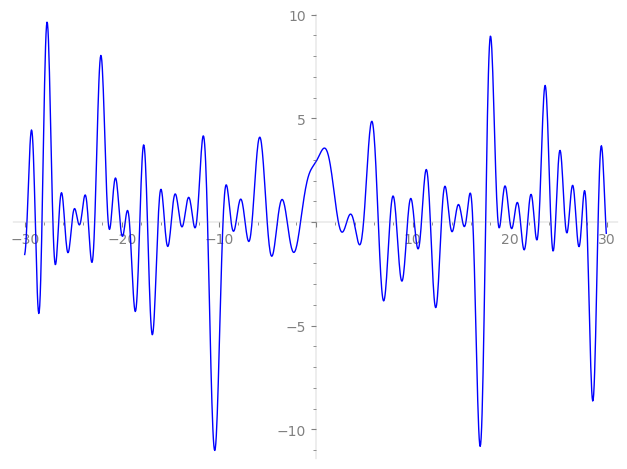| L(s) = 1 | + (0.866 + 0.5i)2-s + (2.59 − 1.5i)3-s + (0.499 + 0.866i)4-s + (−1.23 − 1.86i)5-s + 3·6-s + 0.999i·8-s + (3 − 5.19i)9-s + (−0.133 − 2.23i)10-s + (2.59 + 1.50i)12-s + 2i·13-s + (−6 − 3i)15-s + (−0.5 + 0.866i)16-s + (−1.73 + i)17-s + (5.19 − 3i)18-s + (1 − 1.73i)19-s + (1 − 1.99i)20-s + ⋯ |
| L(s) = 1 | + (0.612 + 0.353i)2-s + (1.49 − 0.866i)3-s + (0.249 + 0.433i)4-s + (−0.550 − 0.834i)5-s + 1.22·6-s + 0.353i·8-s + (1 − 1.73i)9-s + (−0.0423 − 0.705i)10-s + (0.749 + 0.433i)12-s + 0.554i·13-s + (−1.54 − 0.774i)15-s + (−0.125 + 0.216i)16-s + (−0.420 + 0.242i)17-s + (1.22 − 0.707i)18-s + (0.229 − 0.397i)19-s + (0.223 − 0.447i)20-s + ⋯ |
\[\begin{aligned}\Lambda(s)=\mathstrut & 490 ^{s/2} \, \Gamma_{\C}(s) \, L(s)\cr =\mathstrut & (0.830 + 0.556i)\, \overline{\Lambda}(2-s) \end{aligned}\]
\[\begin{aligned}\Lambda(s)=\mathstrut & 490 ^{s/2} \, \Gamma_{\C}(s+1/2) \, L(s)\cr =\mathstrut & (0.830 + 0.556i)\, \overline{\Lambda}(1-s) \end{aligned}\]
Particular Values
| \(L(1)\) |
\(\approx\) |
\(2.75997 - 0.839264i\) |
| \(L(\frac12)\) |
\(\approx\) |
\(2.75997 - 0.839264i\) |
| \(L(\frac{3}{2})\) |
|
not available |
| \(L(1)\) |
|
not available |
\(L(s) = \displaystyle \prod_{p} F_p(p^{-s})^{-1} \)
| $p$ | $F_p(T)$ |
|---|
| bad | 2 | \( 1 + (-0.866 - 0.5i)T \) |
| 5 | \( 1 + (1.23 + 1.86i)T \) |
| 7 | \( 1 \) |
| good | 3 | \( 1 + (-2.59 + 1.5i)T + (1.5 - 2.59i)T^{2} \) |
| 11 | \( 1 + (-5.5 + 9.52i)T^{2} \) |
| 13 | \( 1 - 2iT - 13T^{2} \) |
| 17 | \( 1 + (1.73 - i)T + (8.5 - 14.7i)T^{2} \) |
| 19 | \( 1 + (-1 + 1.73i)T + (-9.5 - 16.4i)T^{2} \) |
| 23 | \( 1 + (-0.866 - 0.5i)T + (11.5 + 19.9i)T^{2} \) |
| 29 | \( 1 - T + 29T^{2} \) |
| 31 | \( 1 + (-5 - 8.66i)T + (-15.5 + 26.8i)T^{2} \) |
| 37 | \( 1 + (6.92 + 4i)T + (18.5 + 32.0i)T^{2} \) |
| 41 | \( 1 - 3T + 41T^{2} \) |
| 43 | \( 1 - 5iT - 43T^{2} \) |
| 47 | \( 1 + (6.92 + 4i)T + (23.5 + 40.7i)T^{2} \) |
| 53 | \( 1 + (5.19 - 3i)T + (26.5 - 45.8i)T^{2} \) |
| 59 | \( 1 + (1 + 1.73i)T + (-29.5 + 51.0i)T^{2} \) |
| 61 | \( 1 + (4.5 - 7.79i)T + (-30.5 - 52.8i)T^{2} \) |
| 67 | \( 1 + (-6.06 + 3.5i)T + (33.5 - 58.0i)T^{2} \) |
| 71 | \( 1 - 6T + 71T^{2} \) |
| 73 | \( 1 + (-8.66 + 5i)T + (36.5 - 63.2i)T^{2} \) |
| 79 | \( 1 + (5 - 8.66i)T + (-39.5 - 68.4i)T^{2} \) |
| 83 | \( 1 - 9iT - 83T^{2} \) |
| 89 | \( 1 + (-3.5 + 6.06i)T + (-44.5 - 77.0i)T^{2} \) |
| 97 | \( 1 - 97T^{2} \) |
| show more | |
| show less | |
\(L(s) = \displaystyle\prod_p \ \prod_{j=1}^{2} (1 - \alpha_{j,p}\, p^{-s})^{-1}\)
Imaginary part of the first few zeros on the critical line
−11.15224408610367439682641640415, −9.556967743266811028641887810856, −8.717407519514583404627009262517, −8.212002623633359773729200142772, −7.28215191276137394092523571041, −6.56490203397105135433768481944, −5.00118432280535199166807086174, −3.95106437028853899356553115478, −2.93846823101421540246862549715, −1.56559820086775594019784258294,
2.33423728391999526839941474582, 3.19718156470117231343074168530, 3.94005557007521707030496466276, 4.93192999322142060820396217217, 6.44921517520472811182374058573, 7.64559655388369570846117701483, 8.309851491065258016233971174370, 9.465954306097583507715565831752, 10.16127692358700866687085143737, 10.89892148996807018289167541845

